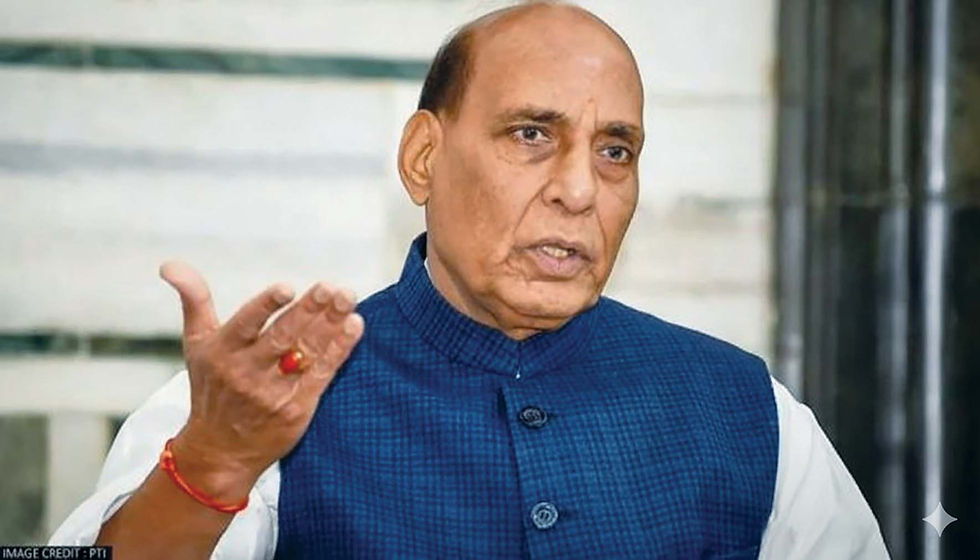The Eagle, the Dragon, the Tiger in a new ‘Cold War’ in Asia
- Commodore S.L. Deshmukh

- Feb 17
- 4 min read
Updated: Feb 18
As the U.S. and China lock horns, India must play its cards right without becoming a pawn in the superpower rivalry.

Benjamin Franklin famously quipped that nothing is certain except death and taxes. In geopolitics, uncertainty is the only constant. With Donald Trump returning to the White House, the United States’ foreign policy is once again taking an unpredictable turn. The newly appointed Secretary of State, Marco Rubio, a noted China hawk, wasted no time in setting a confrontational tone with China. In his first exchange with China’s Foreign Minister, Wang Yi, Rubio reaffirmed America’s commitment to its allies, condemned China’s coercive policies, and promised to put ‘America First.’ China, in turn, issued a stern response, warning Washington to tread carefully. The stage is well-set for a renewed US-China rivalry, one that is likely to have have far-reaching consequences for India.
Under Xi Jinping, China has pursued an aggressive foreign policy, asserting territorial claims in the South China Sea, increasing pressure on Taiwan and clashing with India along the Himalayan border. The Trump administration’s first term had seen significant escalation in tensions between Washington and Beijing, including a trade war, sanctions and diplomatic spats which is only set to intensify in the second term.
Rubio’s record offers clues to what lies ahead. A staunch believer in American exceptionalism, he has been vocal about holding China accountable for its economic and military maneuvers. During Trump’s first term, he played a key role in sanctioning Chinese officials over human rights abuses and supported stronger ties with Taiwan. Now, as Secretary of State, he has made it clear that the US will double down on its commitment to counter China’s influence.
China’s response, led by Wang Yi, has been measured but firm. Unlike his predecessor, Qin Gang, who embodied Beijing’s aggressive ‘wolf warrior’ diplomacy, Wang is a seasoned diplomat known for his pragmatic approach. He has emphasized the need for both nations to manage their differences while preserving areas of cooperation. However, China’s long-term ambitions is to supplant the US as the dominant global power and consolidate its influence in Asia.
Amidst this great power rivalry, India finds itself in a precarious position. It has its own fraught history with China, particularly after the 2020 Galwan Valley clashes, which brought relations between the two Asian giants to their lowest point in decades. At the same time, India has deepened its strategic partnership with the US, joining forums like the Quadrilateral Security Dialogue (QUAD) alongside Japan and Australia. However, the India-US relationship is more fragile than it appears.
Despite converging interests in countering China, India and the US have significant differences. Trade disputes, disagreements over Russia, and Washington’s inconsistent approach towards New Delhi have caused friction. Trump’s transactional style of diplomacy could further complicate matters. While his administration has touted India as a key partner in the Indo-Pacific, his ‘America First’ doctrine could make India wary of fully aligning itself with Washington.
On the other hand, China views India as a rising competitor in Asia. Beijing has been unsettled by India’s growing economic and military clout, its firm stance on territorial disputes, and its opposition to the China-Pakistan Economic Corridor (CPEC). At the same time, China’s close ties with Pakistan and its attempts to encircle India through strategic investments in South Asia have heightened New Delhi’s security concerns.
For India, the challenge is to maintain strategic autonomy without becoming a pawn in the US-China rivalry. New Delhi cannot afford to take sides, as doing so would jeopardize its long-term interests. Instead, it must adopt a nuanced approach that balances engagement with both powers while safeguarding its own strategic imperatives.
Firstly, India must leverage multilateral platforms like the QUAD, the Shanghai Cooperation Organisation (SCO), and BRICS to strengthen its geopolitical position. While the QUAD provides a counterweight to China’s assertiveness, forums like the SCO allow India to engage Beijing diplomatically. This dual approach enables India to keep its options open and avoid over-dependence on any one power.
Secondly, India must continue to build its military and economic capabilities. A strong defence posture, coupled with robust economic growth, will enhance its bargaining power on the global stage. Investments in infrastructure, technology and manufacturing will reduce its reliance on both China and the US, allowing it to chart an independent course.
Lastly, India must refine its diplomatic strategy. It should actively engage with both Washington and Beijing, ensuring that its interests are not sidelined in the larger geopolitical contest. Prime Minister Modi’s government has demonstrated adeptness in balancing relationships with conflicting powers, whether through deepening ties with Russia while maintaining strong relations with the West or managing tensions with China while keeping diplomatic channels open. This approach will be crucial in navigating turbulent waters.
The US-China power struggle is unlikely to abate anytime soon, and India will continue to feel its ripple effects. As Washington and Beijing engage in a high-stakes contest for dominance, New Delhi must resist the temptation to lean too heavily towards either side. Instead, it should focus on strengthening its own position, ensuring that it remains a key player rather than a bystander in global affairs.
In a world of shifting alliances and unpredictable leaders, India’s best bet is to remain flexible, pragmatic and self-reliant. This means playing its cards wisely in an increasingly volatile geopolitical game.
(The author is a retired naval aviation officer and geo-political analyst. Views personal.)





Comments